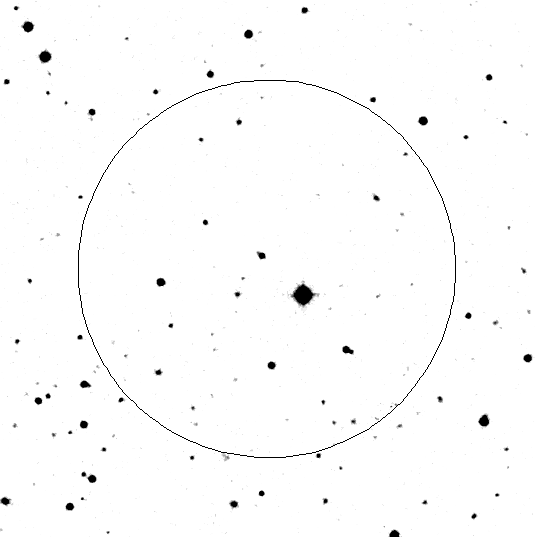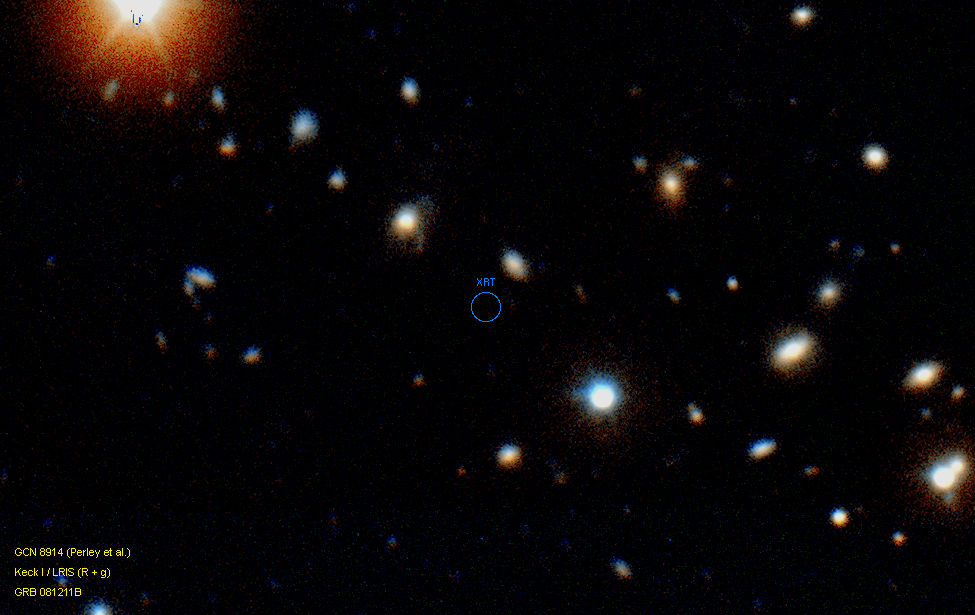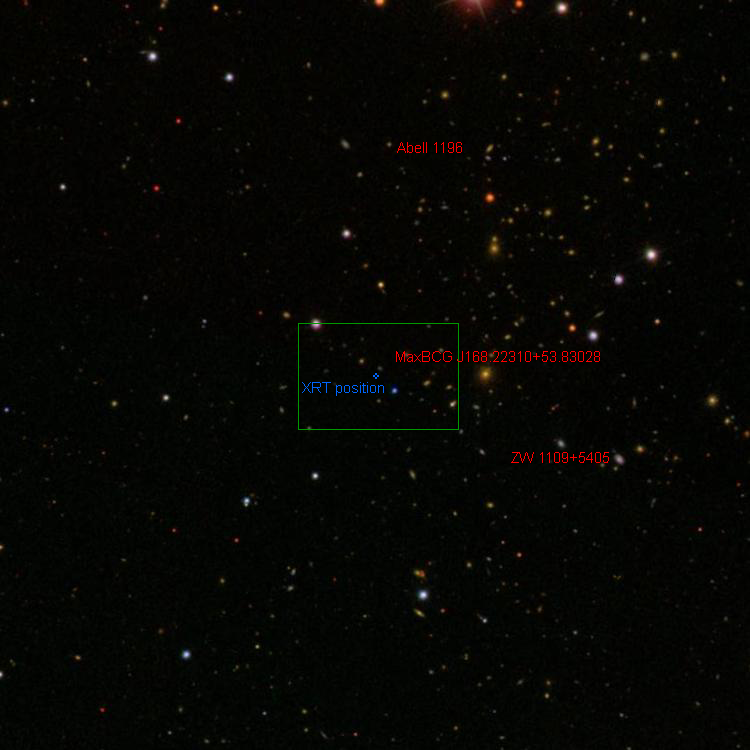- GCN/BACODINE POSITION NOTICE
TITLE: GCN/SWIFT NOTICE
NOTICE_DATE: Thu 11 Dec 08 23:43:50 UT
NOTICE_TYPE: Swift-BAT Slew GRB Position
ID_NUM: 23
GRB_RA: 168.230d {+11h 12m 55s} (J2000),
168.358d {+11h 13m 26s} (current),
167.509d {+11h 10m 02s} (1950)
GRB_DEC: +53.850d {+53d 51' 00"} (J2000),
+53.801d {+53d 48' 04"} (current),
+54.122d {+54d 07' 20"} (1950)
GRB_ERROR: 7.51 [arcmin radius, statistical only]
GRB_INTEN: 1014845 [cnts] Image_Peak=0 [image_cnts]
TRIGGER_DUR: 19.396 [sec]
TRIGGER_INDEX: 9 Criteria: (S(15-50) OR H(50-150)) > 4.0 sigma AND B(15-150) > 6.0 sigma
ENERGY_RANGE: 15-150 keV
BKG_INTEN: 0 [cnts]
BKG_TIME: 0.00 SOD {00:00:00.00} UT
BKG_DUR: 0 [sec]
GRB_DATE: 14811 TJD; 346 DOY; 08/12/11
GRB_TIME: 22579.18 SOD {06:16:19.18} UT
SOLN_STATUS: 0x4011
RATE_SIGNIF: 0.00 [sigma]
IMAGE_SIGNIF: 0.00 [sigma]
SUN_POSTN: 259.47d {+17h 17m 53s} -23.08d {-23d 05' 03"}
SUN_DIST: 109.08 [deg] Sun_angle= 6.1 [hr] (West of Sun)
MOON_POSTN: 67.84d {+04h 31m 21s} +26.33d {+26d 19' 44"}
MOON_DIST: 74.86 [deg]
MOON_ILLUM: 99 [%]
GAL_COORDS: 150.34, 57.72 [deg] galactic lon,lat of the burst (or transient)
ECL_COORDS: 143.23, 43.87 [deg] ecliptic lon,lat of the burst (or transient)
COMMENTS: SWIFT-BAT Slew GRB Coordinates.
COMMENTS: A point_source was found.
COMMENTS: This does not match any source in the ground catalog.
COMMENTS: This is probably a GRB.
COMMENTS: High confidence of reality (silver-plated).
COMMENTS: This Notice was ground-processed from flight-data.
- red DSS finding chart
ps-file

- GCN Circular #8661
A. Copete, J. Grindlay (Harvard)
S. Barthelmy, C. Markwardt, N. Gehrels (NASA/GSFC)
We report the detection of a likely GRB candidate by the BAT Slew
Survey (BATSS) in the slew that started on 12/11/08 at 06:15:02 UT and
lasted 121 sec. The ground-calculated position is RA, Dec = 168.231,
+53.845 deg, which is
RA (J2000) = 11h 12m 55s
Dec(J2000) = +53d 50' 43"
with an uncertainty of 3.04 arcmin (90% confidence, including
systematics). The detection was triggered by simultaneous detections
of 7.4 sigma and 8.3 sigma from imaging in the overlapping energy
bands of 15-50 keV and 15-150 keV, respectively. The burst mask-tagged
lightcurve in the 15-150keV band shows two possible broad peaks in its
emission profile that span the entire 102 sec that the source remains
within the BAT field-of-view, starting at T+18 sec, and peaking T+34
and T+69 sec, suggesting that this is possibly the tail end of the
prompt emission of a burst at that location.
The time-averaged spectrum over the 102 sec of exposure of the source
is best fit by a simple power law with photon index 1.73, and the
fluence in the 15-150 keV band is 6.1 x 10^-7 erg/cm^2
A follow-up Swift ToO observation has been scheduled to begin on
12/12/08 at 04:51 UT, 22.6 hours after the burst.
Optical/IR observations of this potential GRB are encouraged
immediately, as it is well positioned for northern hemisphere observers.
- GCN Circular #8666
K.L. Page, P.A. Evans (U. Leicester) and S.T. Holland (CRESST/USRA/GSFC)
report on behalf of the Swift-XRT team:
Swift-XRT performed a Target of Opportunity observation of the possible
BAT Slew Survey (BATSS) burst GRB 081211B (Copete et al., GCN Circ. 8661),
starting 81.6 ks after the slew in which it was detected, and found a
single, uncatalogued X-ray source within the BATSS error circle.
Using 1878 s of XRT Photon Counting mode data and 4 UVOT images, we find
an astrometrically corrected X-ray position (using the XRT-UVOT alignment
and matching UVOT field sources to the USNO-B1 catalogue): RA, Dec =
168.2646, 53.8300 which is equivalent to:
RA (J2000): 11 13 3.49
Dec (J2000): +53 49 48.1
with an uncertainty of 2.0 arcsec (radius, 90% confidence).
During the initial observation (81.6-92 ks), the mean X-ray count rate was
0.035 +/- 0.005 count s^-1. A second observation (126-133 ks) showed a
count rate of 0.018 +/- 0.006. The source, therefore, appears to have
faded, with a power-law index, alpha = 1.4 +0.8/-0.9. However, we cannot
rule out a constant source at this time, so cannot categorically confirm
this is an X-ray afterglow.
This is an official product of the Swift-XRT team.
- GCN Circular #8669
S. T. Holland (CRESST/GSFC/USRA) reports, on the behalf of the Swift
UVOT team:
The Swift/UVOT observed the field of the possible BAT Slew
Survey burst GRB 081211B (Copete et al., GCN Circ. 8661) starting 81.7
ks after the start of the slew that this source was detected in. We
find no new source, relative to the DSS, USNO-B1.0, or 2MASS, or a
variable source, inside the UVOT-enhanced XRT error circle (Page et
al. 2008, GCN Circ. 8666). Preliminary 3-sigma upper limits for
detecting a source in the co-added images, using an aperture-corrected
2.5 arcsecond radius circular aperture, are
Filter T_start T_stop Exp(s) Mag
------------------------------------------
v 81,651 132,774 2318 >21.4
b 85,687 126,980 1770 >22.5
uvm2 132,780 133,265 478 >20.8
uvw2 87,513 128,664 1426 >21.8
white 86,600 127,893 1770 >23.1
------------------------------------------
The quoted upper limits have not been corrected for the expected
Galactic extinction along the line of sight corresponding to a
reddening of E_{B-V} = 0.01 mag (Schlegel et al., 1998, ApJS, 500,
525). All photometry is on the UVOT photometry system described in
Poole et al. (2008, MNRAS, 383, 627).
- GCN Circular #8676
S. Golenetskii, R. Aptekar, E. Mazets, V. Pal'shin, D. Frederiks, and
and T. Cline, on behalf of the Konus-Wind team,
J. Cummings, S. Barthelmy, N. Gehrels, and H. Krimm, on behalf of
the Swift-BAT team,
On December 11, Konus-Wind detected in the waiting mode a short spike at
06:12:58 UT, ~120 s before the BATSS GRB 081211B (Copete et al., GCN
8661). The burst was seen as a single 2.9s-long spike in the G1 (20-70
keV) and G2 (70-300 keV) bands. The BAT also detected this burst at
06:12:55.1 UT as a weak single pulse that did not produce a significant
on-board image. The BATSS position of GRB 081211B was 1.3% coded in the
BAT at the time of this burst.
The measured propagation time delay from Swift to Wind as well as the
K-W ecliptic latitude response for a short spike are consistent with the
position of GRB 081211B. Hence, taking in account that the BATSS
GRB081211B light curve shape suggests that it is possibly the tail end
of the prompt emission of a burst (Copete et al., GCN 8661), we believe
that the short spike detected by Konus-Wind and BAT is the main burst
(likely short), followed by a long tail (extended emission) seen as the
BATSS GRB081211B.
There is a hint of the extended emission in the K-W G1 and G2 bands.
The K-W light curve of this GRB is available at
http://www.ioffe.ru/LEA/GRBs/GRB081211B/
- GCN Circular #8683
K.L. Page, J.P. Osborne (U. Leicester) and S.T. Holland (CRESST/USRA/GSFC)
report on behalf of the Swift-XRT team:
The possible BAT Slew Survey burst GRB 081211B has been observed again by
Swift, 8 days after it was first located. The source mentioned by Page et
al. in GCN Circ. 8666 is not detected in 2.3 ks of XRT data, with an upper
limit of 4.3x10^-3 count s^-1 (equivalent to a 0.3-10 keV observed flux of
~1.6x10^-13 erg cm^-2 s^-1). The decay slope is 1.6 +0.9/-0.6,
incorporating the limit placed by this non-detection. We therefore confirm
that the source has faded.
This is an official product of the Swift-XRT team.
- GCN Circular #8727
M. Andreev, A. Sergeev (Terskol Branch of Institute of Astronomy), Ju.
Babina (CrAO), A. Pozanenko (IKI) on behalf of larger GRB follow up
collaboration report:
We observed the field of GRB 081211B (Copete et al., GCN 8661) with
Zeiss-600 telescope of Mt. Terskol observatory on Dec.13 in R-band. In the
XRT error box (Page et al., GCN 8666) we do not detect any optical source. A
photometry of the combined image is following:
Mid time (UT) Exposure R_mag (3 sigma)
s
08-12-13 02:10:40 85x60 >21.1
- GCN Report 189.1
GCN_Report 189.1 has been posted:
http://gcn.gsfc.nasa.gov/reports/report_189_1.pdf
by S.T. Holland
at CRESST/USRA/GSFC
titled: "Final Swift observations of Possible GRB 081211B"
- GCN Circular #8914
D. A. Perley, J. S. Bloom, and N. R. Butler (UC Berkeley) report:
GRB 081211B was discovered in the Swift-BAT slew survey (Copete et al,
GCN 8661) and, based on observations by Konus-Wind (Golenetskii et al.,
GCN 8676), was classified as a possible short burst with an extended
emission component. We note that the GRB localization lies within a
visual galaxy overdensity in SDSS archival imaging, and near the centers
of several reported clusters in the literature, which likely correspond
to the same physically extended structure: ZW 3893, Abell 1196, and
MaxBCG J168.22310+53.83028.
Redshifts from the Sloan Digital Sky Survey of the brightest two
apparent cluster members place this cluster at a probable redshift of
z=0.216.
On the night of 2009-02-19 (UT) we observed the field with Keck I (+
LRIS) for an exposure time of 990 sec (g-band) and 870 sec (R-band)
simultaneously through thin cloud cover. No host galaxy underlying the
XRT position (Page et al., GCN 8666) is detected to approximately R >
25, g > 26 mag. The nearest catalogued objects are:
SDSS J111303.09+534953.8 g=21.26 r=20.26 i=20.03 (7" = 24 kpc)
SDSS J111304.73+534959.5 g=20.56 r=19.25 i=18.84 (16" = 56 kpc)
An additional very faint extended object is located 3" west of the
center of the XRT position, outside the 90% confidence error circle.
Images of the field (from our observations and from SDSS) are posted to:
http://lyra.berkeley.edu/~dperley/081211b/081211b_keck.png
http://lyra.berkeley.edu/~dperley/081211b/081211b_sdss.png
If the BAT detection represents extended emission from this event and no
fainter host galaxy is found, this would constitute an additional case
of a short GRB event with detected extended emission occurring without a
coincident host galaxy (after GRB 080503 - arXiv:0811.1044), as well as
an additional example of a short burst occurring within a galaxy cluster
(see also e.g. GRBs 050509B, 050813, 051210, 061201). The isotropic
gamma-ray energy release at the cluster redshift would be 7 x 10^49 erg
in the BAT bandpass, comparable to values measured for other short GRBs.
We encourage deeper observations of the field.


![]() Previous IAU Circulars
Previous IAU Circulars 

